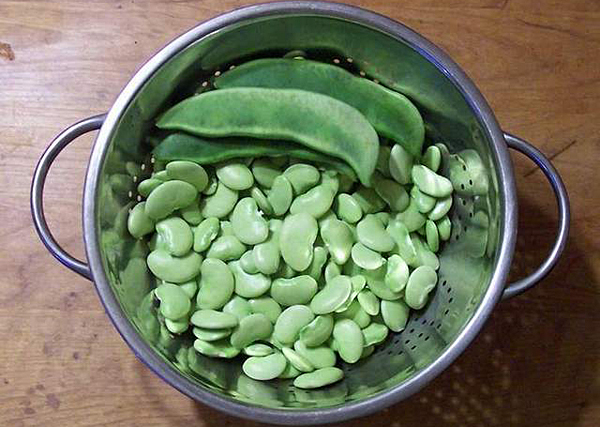
For the love of limas
Local varieties are a unique part of Delaware's 'lima bean culture'
11:33 a.m., May 3, 2011--April 20 was National Lima Bean Respect Day but in Ronald Dodd’s eyes, limas deserve kudos every day of the year.
The Georgetown septuagenarian has been growing pole limas since he was a boy and says that his father and grandfather grew them before he did. Dodd’s 55- by 147-foot garden, on land he owns one block off Georgetown’s Circle, features 42 to 45 hills of pole limas each season.
Campus Stories
From graduates, faculty
Doctoral hooding
Come harvest time, he’ll enjoy pole limas in succotash accompanied by baking powder biscuits, just like scores of other native Delawareans.
But head a couple hundred miles from the First State, or talk to new state residents, and you may get puzzled looks at the mention of pole limas. “At conferences, I’ve met people in the agricultural industry who have never heard of pole limas,” says Emmalea Ernest, a University of Delaware Cooperative Extension associate who specializes in lima bean research. “But there is a long tradition of growing pole limas here; there is a real lima bean culture in Delaware.
“As a plant breeder, the most interesting thing to me about pole lima beans is that it is still possible to find people in Delaware who are growing local landrace varieties that they have selected themselves or that have been passed down in their families. For other vegetables, even though there are lots of people out there growing heirloom varieties, they got the seed from Burpee, not their grandmother.”
Lima beans are a big business in Delaware. Limas are grown on more acres in the state than any other vegetable crop. However, the commercial market is made up almost entirely of baby limas and Fordhooks, not pole limas. These baby limas and Fordhooks are grown for processing, which, nowadays, means flash-frozen, not canned.
If you want to eat fresh lima beans this summer, you’ll need to be on the look-out for pole limas at farmers’ markets, particularly markets in Sussex or Kent counties. Or, better yet, you can grow them yourself, suggests Ernest.
She knows, though, that some folks may need convincing that it’s worth the effort to grow limas, pole or otherwise. Maybe they weren’t paying attention on National Lima Bean Respect Day. Or, more likely, they still have vivid memories from childhood of mushy, over-cooked canned limas heaped high on dinner plates or school lunch trays.
There’s nothing worse than a soggy canned lima but these days, flash-frozen baby and Fordhook limas are tasty and have a nice, firm texture, says Ernest.
And there’s absolutely nothing better than a fresh-picked pole lima, she says. “The taste of a pole lima is delicious and the pole lima isn’t starchy, unless you leave it on the vine too long. My four-year-old daughter, Irene, just gobbles them up.”
As an added bonus, pole limas – and limas in general – are nutritional powerhouses. They’re rich in fiber, potassium, iron, copper and manganese.
In her own Ellendale garden, Ernest doesn’t bother growing baby limas or Fordhooks – “I am able to get enough of them at work,” she says. But she has devoted 400 feet of trellis to pole limas.
If you want to grow pole limas this summer, now’s the time to prepare. Pole limas have a long growing season and should be planted between mid-May and early June. Pole limas can be grown on teepees but Ernest prefers trellises because teepees can blow over in windy conditions. Pole limas can tolerate New Castle County’s heavy, clay soils as well as Sussex’s sandy conditions.
Ernest starts her pole lima plants from seed. You can buy seeds online; pole lima plants are available at some independent nurseries and farmers markets. One of the most popular varieties is Dr. Martin, an heirloom that features 16- to 20-foot-long vines bearing large, flat pods. Big Mama and King of the Garden are other local favorites. For something different, try the Christmas Lima, sporting a red and white speckled bean that has a butter-like texture and a subtle chestnut-like flavor.
Pole limas need a lot of room and should be planted four to six feet apart. To keep your pole limas happy, Ernest says to go heavy on the watering and light on the fertilizing. Keep an eye out for spider mites and stink bugs; the two most common lima pests. Pod development should start occurring in mid- to late-August, with mature beans ready to pick about three weeks later. Pods will continue to develop into September.
If you have a bumper crop of pole limas you can freeze them or, like Ronald Dodd, you can give the excess to friends and neighbors. “I have plenty of ‘customers’ who like to get some of my pole limas,” says Dodd. “But last year was not a great season; I didn’t have any extra to give away.”
Plenty of native Delawareans – and Delawareans in the know – will be hoping for better pole lima yields this growing season.
Article by Margo McDonough
Photo by Danielle Quigley








